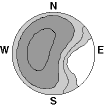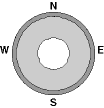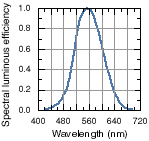| ciel serein normalisé CIE (FR)
klarer Himmel nach CIE (DE)
cielo despejado patron CIE (ES)
cielo sereno secondo CIE (IT)
heldere-hemelstandaard
van de CIE (NL)
CIE standard klar himmel (NO)
niebosklon bezchmurny
znormalizowany CIE (PL)
CIE standard för klar himmel (SE)

| | sky, CIE standard clear

CIE. Cloudless sky for which the relative luminance distribution is described in CIE Publication N°22 (1973). Example:


|
| ciel couvert normalisé CIE (FR)
bedeckter Himmel nach CIE (DE)
cielo cubierto patron CIE (ES)
cielo coperto secondo CIE (IT)
betrokken-hemelstandaard
van de CIE (NL)
CIE standard
overskyet himmel (NO)
nieboskton pokryty
znormalizowany CIE (PL)
CIE standard föt mulen himmel (SE)

| | sky, CIE standard overcast

CIE. Completely overcast sky for which the ratio of its luminance  in the direction at an angle in the direction at an angle  above the horizon to its luminance above the horizon to its luminance  at the zenith is given by the relation: at the zenith is given by the relation:



|
| ciel nuageux (FR)
bewölkter Himmel (DE)
cielo nublado (ES)
cielo nuvoloso (IT)
skyet himmel (NO)

| | sky, cloudy

Sky condition corresponding to a cloud index larger than 0.6.

|
| ciel intermédiaire (FR)
mittlerer Himmel (DE)
cielo intermediario (ES)
cielo intermediario (IT)
delvis skyet himmel (NO)

| | sky, intermediate

Sky condition corresponding to a cloud index larger than 0.15 and smaller than 0.6.

|
| ciel ensoleillé (FR)
klarer Himmel (DE)
cielo soleado (ES)
cielo soleggiato (IT)
solrik himmel (NO)

| | sky, sunny

Sky condition corresponding to a cloud index smaller than 0.15.

|
| lumière du ciel (FR)
Himmelslicht (DE)
luz del cielo (ES)
luce dal cielo (IT)
hemellicht (NL)
himmellys (NO)
olwietlenie sloneczne
rozproszone (PL)
himmelsljus (SE)

| | skylight

CIE. Visible part of diffuse sky radiation.

|
| pente (FR)
Neigungswinkel (DE)
pendiente (ES)
pendenza (IT)
helningsvinkel (NO)

| 
| slope

Unit: degree

Angle of a plane with respect to the horizontal. A horizontal surface has a slope angle of 0 degree. A vertical surface has a slope angle of 90 degrees.

|
| azimut solaire (FR)
Azimuthwinkel der Sonne (DE)
acimut solar (ES)
azimut solare (IT)
solasimut (NO)

| 
| solar azimuth

Unit: degree

Azimuth angle of the sun. Measured clockwise with respect to true north.

|
| constante solaire (FR)
Solarkonstante (DE)
constante solar (ES)
constante solare (IT)
zonneconstante (NL)
solarkonstant (NO)
stala sloneczna (PL)
solarkonstant (SE)

| 
| solar constant

CIE. Irradiance produced by the extraterrestrial solar radiation on a surface perpendicular to the sun’s rays at mean yearly sun-earth distance (150 Million km).
Eesno = 1367 W/m2 (Final report No.590 of the Commission for instruments and methods of observation: CIMO-VIII of the World Meteorological Organization, Mexico City, October 1981).

|
| déclinaison solaire (FR)
Deklination der Sonne (DE)
descline solar (ES)
declinazione solare (IT)
solens deklinasjon (NO)

| 
| solar declination

Unit: degree

Angle between the sun's rays and the earth's equatorial plane. Declination values are positive when the sun is north of the equator (March 20 to September 23) and negative when the sun is south of the equator. Its maximum and minimum values are +23.45 and -23.45 degrees.

|
| hauteur du soleil (FR)
Sonnenhöhenwinkel (DE)
altura del sol (ES)
altezza del sole (IT)
solhøyde (N0)

| 
| solar elevation

Unit: degree

Angle between the centre of the sun's disc and the horizon. It is only approximately the angle of the centre of the sun above the horizon, because near the horizon the apparent position of the sun is affected by refraction in the atmosphere.

|
| angle horaire du soleil (FR)
Stundenwinkel der Sonne (DE)
ángulo horario del sol (ES)
angolo orario del sole (IT)
solens timevinkel (NO)

| 
| solar hour angle

Unit: degree

The angle at which the earth must turn to bring the meridian of the given point directly under the sun. Negative in the morning: sun coming from the east. Positive in the afternoon: sun going west. This angle increases by 15 degrees an hour.

|
| angle horaire du soleil
au lever et au coucher (FR)
Stundenwinkel der Sonne bei
Sonnenaufgang und Sonnenuntergang (DE)
ángulo horario del sol
al amanecer y al anochecer (ES)
angolo orario del sole
all alba e al tramonto (IT)
solens timevinkel ved
soloppgang og solnedgang (NO)

| 
| solar hour angle at sunrise and sunset

Unit: degree

The solar hour angle at sunrise and sunset.

|
| rayonnement solaire (FR)
Solarstrahlung (DE)
radiación solar (ES)
radiazione solare (IT)
zonnestraling (NL)
solstråling (NO)
promienioiwanie sloneczne (PL)
solstralning (SE)

| | solar radiation

CIE. Electromagnetic radiation from the sun. On average, 98% of the sun's radiation reaching the earth falls in the spectral range between 0.29 µm and 4 µm.

|
| angle solaire zénithal (FR)
Sonnenzenitwinkel (DE)
ángulo solar zenital (ES)
angolo solare zenitale (IT)
solens senit vinkel (NO)

| 
| solar zenith angle

Unit: degree

Angle between the centre of the sun's disc and the vertical:  . .

|
| angle solide (FR)
Raumwinkel (DE)
ángulo sólido (ES)
angolo solido (IT)
romvinkel (NO)

| 
| solid angle

Unit: steradian

Area intercepted on a unit sphere by a conical angle originating at the sphere center.

|
| efficacité lumineuse
relative spectrale (FR)
Spektrale Lichtausbente (DE)
eficiencia luminosa
espectral relativa (ES)
fattore spettrale
di visibilita (IT)
relatieve spectrale
ooggevoeligheid (NL)
spektral lysvirkningsgrad (NO)
skutecznosc swietlna
widmowa wzgledna (PL)
spektral ljusverkningsgrad (SE)

| 
| spectral luminous efficiency (of a monochromatic radiation of a given wavelength)

Unit: 1

CIE. Ratio of the radiant flux at wavelength  to that at wavelength to that at wavelength  such that both radiations produce equally intense luminous sensations under specified photometric conditions and such that both radiations produce equally intense luminous sensations under specified photometric conditions and  is chosen so that the maximum value of this ratio is equal to 1. The values used for the spectral luminous efficiency in photopic vision can be found in the CIE publication N°86 (1988). They are also recommended by the International Committee of Weights and Measures. Example in photopic vision: is chosen so that the maximum value of this ratio is equal to 1. The values used for the spectral luminous efficiency in photopic vision can be found in the CIE publication N°86 (1988). They are also recommended by the International Committee of Weights and Measures. Example in photopic vision:


|
| stéradian (FR)
Steradiant (DE)
estereorradian (ES)
steradiante (IT)
steradiaal (NL)
steradian (NO)
steradian (PL)
steradian (SE)

| 
| steradian

CIE. SI unit of solid angle. Solid angle that, having its vertex at the centre of a sphere, cuts off an area of the surface of the sphere equal to that of a square with sides of length equal to the radius of the sphere (ISO, 31/1-2.1, 1978).

|
| facteur de correction
de la distance terre soleil (FR)
Exzentrizitätskorrektur (DE)
factor de corrección
de la distancia sol-tierra (ES)
fattore di correzione
della distanza terra sole (IT)
korreksjonsfaktor for
sol-jord avstand (NO)

| 
| sun-earth distance correction factor

Unit: 1

Ratio between the daily value of the sun-earth distance and its mean yearly value (150 Million km). Its value is computed according CIE publication N°85 (1989):

Where  is the day of the year also called the Julian day (from 1 to 365, or 366 if the year is bissextile). is the day of the year also called the Julian day (from 1 to 365, or 366 if the year is bissextile).

|
| lumière solaire (FR)
Sonnenlicht (DE)
luz solar (ES)
luce solare (IT)
zonlicht (NL)
sollys (NO)
oswietlenie sloneczne bezposrednie (PL)
solljus (SE)

| | sunlight

CIE. Visible part of direct solar radiation.

|
| durée d’ensoleillement (FR)
Sonnenscheindauer (DE)
tiempo de insolación (ES)
soleggiamento (IT)
gesommeerde
zonneschijnduur (NL)
solskinnsvarighet (NO)
csas trwania naslonecznienia (PL)
solskenstid (SE)

| 
| sunshine duration

Unit: hour

Sum of time intervals within a given time period (hour, day, month, year) during which the irradiance from direct solar radiation on a plane normal to the sun direction is equal to or greater than 120 W/m2. This limit has been set by the World Meteorological Organization in 1981, before this date, it was 200 W/m2.

|
| durée astronomique
d’ensoleillement (FR)
astronomische
Sonnenscheindauer (DE)
tiempo de insolación
astronómico (ES)
soleggiamento
astronomico (IT)
astronomische
zonneschijnduur (NL)
astronomisk solskinnsvarighet (NO)
czas trwania naslonecsnienia
astronomiczny (PL)
astronomisk solskenstid (SE)

| 
| sunshine duration, astronomical
Unit: hour

CIE. Sum of the time intervals within a given time period during which the sun is above an even, unobscured horizon. This is equivalent to the period during which the solar elevation is greater than 0. The sun is actually hidden only when the solar altitude is below about -0.84 degrees due to the apparent radius of the sun (0.27 degrees) and atmospheric refraction.

|
| durée possible
d’ensoleillement (FR)
mögliche
Sonnenscheindauer (DE)
tiempo de insolación
posible (ES)
soleggiamento
possibile (IT)
maximale
zonneschijnduur (NL)
mulig solskinnsvarighet (NO)
czas trwania naslonecsnienia
mozliwy (PL)
möjlig solskenstid (SE)

| 
| sunshine duration, possible (at a particular location)

Unit: hour

CIE. Sum of the time intervals within a given time period during which the sun is above the real horizon, which may be obscured by mountains, buildings, trees, etc.

|
| durée relative d’ensoleillement (FR)
relative Sonnenscheindauer (DE)
tiempo de insolación relativo (ES)
soleggiamento relativo (IT)
relatieve zonneschijnduur (NL)
relativ solskinnsvarighet (NO)
czaq trwania naslonecznienia
wzgledny (PL)
relativ solskenstid (SE)

| 
| sunshine duration, relative

Unit: 1 or %

Usually, this is the ratio of the sunshine duration to the possible sunshine duration within the same period. This requires to know the local topography at the location.
Since there is no way to obtain this information for all locations covered by Satel-Light, we use the ratio of the sunshine duration for unobscured horizon, to the astronomical sunshine duration.

|
| facteur total de trouble (FR)
Trübungsfaktor (DE)
factor total de turbidez (ES)
fattore totale di torbidita (IT)
troebelheidsfactor (NL)
total turbiditetsfaktor (NO)
wspotczynnik zmetnienia
(weslug Linke) (PL)
turbiditetsfaktor (SE)

| 
| total turbidity factor (according to Linke)

Unit: 1

CIE. Ratio of the vertical optical thickness of a turbid atmosphere to the vertical optical thickness of the pure and dry atmosphere (Rayleigh atmosphere), related to the total solar spectrum:

Where  is the optical thickness with respect to Raleigh scattering at the air molecules, is the optical thickness with respect to Raleigh scattering at the air molecules,  are the optical thicknesses with respect to Mie scattering and absorption at the aerosol particles, to ozone absorption, and to water vapor absorption respectively. are the optical thicknesses with respect to Mie scattering and absorption at the aerosol particles, to ozone absorption, and to water vapor absorption respectively.

|
| facteur de transmission (FR)
Tansmission (DE)
transmitancia (ES)
fattore di transmissione (IT)
transmittans;
transmisjonsfaktor (NO)

| 
| transmittance (for incident radiation of given spectral composition, polarization and geometrical distribution)

Unit: 1

Ratio of the transmitted radiant or luminous flux to the incident flux in the given conditions.

|
| heure solaire vraie (FR)
Wahre Sonnenzeit (DE)
hora solar verdadera (ES)
ora solare vera (IT)
sann soltid (NO)

| 
| true solar time

Unit: hours from midnight

True solar time differs from clock time. It is specific to a location. At 12:00 solar time, the sun is exactly south. The difference between true solar time and clock time is due to (1) differences between the site longitude  and the standard meridian (the reference for clock time), (2) the equation of time ET and (3) summer time (one hour), if applied: and the standard meridian (the reference for clock time), (2) the equation of time ET and (3) summer time (one hour), if applied:


|
| indice de variabilité (FR)
Variabilitätsindex (DE)
variabilitetsindeks (NO)

| 
| variability index

Unit: 1

Root mean squared deviation between the clear sky index at time t and the clear sky indices at time t- and t+ and t+ : :


|
| rayonnement visible (FR)
sichtbare Strahlung (DE)
radiación visible (ES)
radiazione visibile (IT)
zichtbare straling (NL)
synlig stråling (NO)
promieniowanie widzialne (PL)
synlig stralning (SE)

|
| visible radiation

CIE. Any optical radiation capable of causing a visual sensation directly. There are no precise limits for the spectral range of visible radiation since they depend upon the amount of radiant power reaching the retina and the responsivity of the observer. The lower limit is generally taken between 360 nm and 400 nm and the upper limit between 760 nm and 830 nm.
|
| plan utile; plan de travail (FR)
Nutzebene (DE)
plano de trabajo (ES)
piano utile (IT)
werkvlak (NL)
arbeidsplan (NO)
plaszczyzna robocza (PL)
arbetsplan (SE)

|
| work plane

CIE. Reference surface defined as the plane at which work is usually done.
In Satel-Light, this plane is a horizontal plane 0.80 m above the floor and limited by the walls of the room.

|
| angle zénithal (FR)
Zenitwinkel (DE)
ángulo zénital (ES)
angolo zenitale (IT)
senitvinkel (NO)

| 
| zenith angle

Unit: degree

Angle between a point in the hemisphere and the vertical:  . .

|


